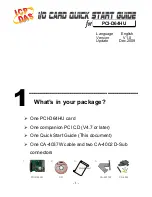
Rev 4.0/8-17
6
N4950/N10TAIR: #35105
INTENDED USE
L
OAD
C
HARACTERISTICS
WARNING: This hand cup is NOT intended for lifting hazardous materials, such
as explosives or radioactive substances.
The operator must verify that the hand cup is intended to handle each load, in accordance with
the following requirements:
• The load must not exceed the allowable weight specified under Maximum Load Capacity (see
SPECIFICATIONS).
• The load must be a single piece of nonporous or semiporous material with a flat and relatively
smooth contact surface.
4
To determine whether the load is too porous or rough, simply
attach the hand cup to the contact surface (see OPERATION: T
O
A
TTACH THE
H
AND
C
UP TO A
L
OAD
) and determine whether the red-line vacuum indicator would remain hidden during a lift
(see OPERATION: T
O
L
IFT AND
M
OVE THE
L
OAD
: About the Red-Line Vacuum Indicator).
If not,
the load does not possess the characteristics required for using this hand cup.
• The load's contact surface must be suitable for obtaining a friction coefficient of 1 with the
hand cup's vacuum pad (see MAINTENANCE: V
ACUUM
P
AD
M
AINTENANCE
: Friction Coefficient),
as verified by a friction test. If necessary, contact Wood's Powr-Grip for help in conducting a
friction test.
• In order to avoid damaging the vacuum pad, the load's surface temperature must not exceed
the allowable Operating Temperatures (see SPECIFICATIONS). However, if such an
application cannot be avoided, Wood's Powr-Grip does offer a heat-resistant rubber
compound and other solutions which may enable you to lift loads with higher surface
temperatures. Contact Wood’s Powr-Grip or an authorized dealer for more information.
• While the
minimum length and width of the load are determined by the Pad Spread (see
SPECIFICATIONS), the
maximum length and width are determined by the allowable
overhang, or the amount of load material that can extend sideways beyond the vacuum pad
without breaking or otherwise being damaged.
The allowable overhang depends on the kind of load material being lifted, the thickness of the
material, and the angle at which it is handled (if any). Since materials such as glass, stone or
sheet metal each have different physical properties, the allowable overhang must be
evaluated separately for each type of load. If necessary, contact Wood’s Powr-Grip or an
authorized dealer for help in determining the recommended overhang in a specific situation.
• Although the thickness of the load is not restricted for this hand cup, load thickness may affect
the angle of load orientation and the amount of operator effort required for handling loads.
Note: Vacuum pads can stain or deform load surfaces with light colors or soft coatings. The
operator should test such surfaces for detrimental effects before using the hand cup on them.
4
Hand cups that feature concave vacuum pads can also attach to some kinds of curved loads. Since curvature affects the lifting
capacity, contact Wood’s Powr-Grip for help in determining the Load Capacity for a particular curved load.
Summary of Contents for N10TAIR
Page 2: ......




































